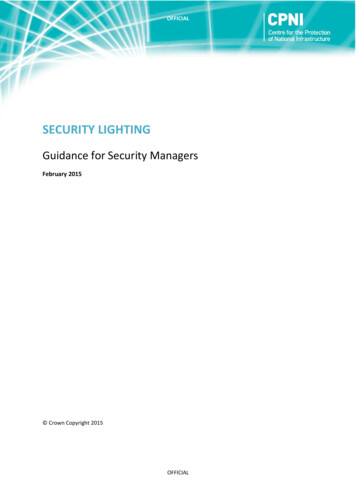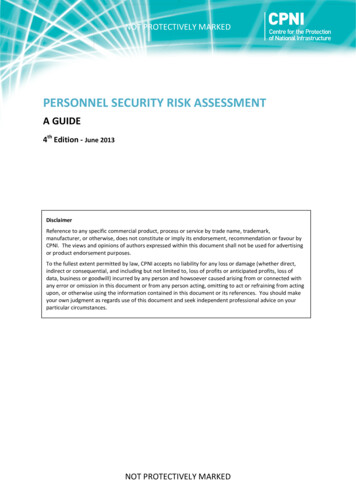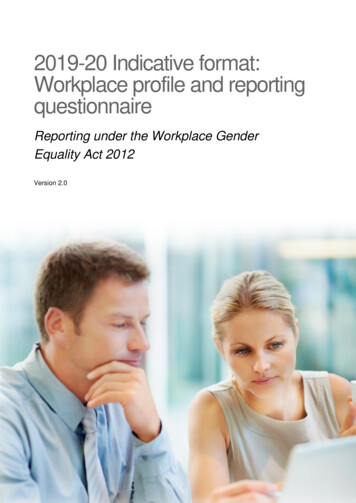
Transcription
OFFICIALSECURITY LIGHTINGGuidance for Security ManagersFebruary 2015 Crown Copyright 2015OFFICIAL
OFFICIALContentsFOREWORD . 6ACKNOWLEDGEMENTS . 6OVERVIEW . 6REFERENCES . 7ABBREVIATIONS & ACRONYMS . 8WELCOME TO SECURITY LIGHTING . 9Purpose . 9Crime and Lighting . 10Basic Requirements . 12WHERE TO START – THE OPERATIONAL REQUIREMENT . 13WHAT IS LIGHT ? . 14Deriving Lighting Units. 14Illuminance . 15Other Lighting Units. 16Reflected Light (Luminous Exitance) . 17Brightness (Luminous Intensity & Luminance) . 17Efficacy . 18LEVELS OF ILLUMINATION . 18Human Vision . 18Practicalities . 18A problem with using the Lumen ? . 19LIGHTING FOR USE WITH CCTV . 21ISSUES WITH IR ILLUMINATION. 22Lighting quality . 22CCTV Lens performance . 22Reflectance . 23Eye Safety . 24LAMP SELECTION . 24Artificial Light Sources . 24Lamp types. 25Luminaire Type . 26Luminaire Cost . 26OFFICIAL2
OFFICIALRunning Cost . 27Lamp Life . 27Run-up Time . 28Lamp Re-strike Time . 28Colour Rendering . 29LAMP SAFETY AND DISPOSAL . 30LUMINAIRES . 31Strength . 31Choosing the Correct Luminaire . 31STANDARDS, GUIDANCE AND ADVICE . 33Commercial Companies . 33Public Standards . 33Government bodies . 34Government Security . 34Other sources: . 34Clean Neighbourhoods and Environment Act . 35LIGHTING SCHEMES . 36General . 36Perimeter Lighting . 36Glare Lighting . 37Area Lighting . 39Asset Lighting or Flood Lighting . 40Event Activated Lighting . 40Displacement Lighting . 41Entrance / Check Point Lighting . 42Search Area Lighting . 42Guardhouse and Office Lighting . 43INSTALLED SYSTEMS . 44Specifications . 44Lighting Controls . 44Power and Cabling Considerations. 45Columns & Hardware . 46MAINTENANCE . 48General . 48Purpose of Maintenance. 48Requirements . 49Disposal . 49OFFICIAL3
OFFICIALAUDIT, REVIEW & OPERATION . 50Why take readings?. 50Audit Requirements . 50Matching Threat Levels . 50FUTURE TRENDS . 52APPENDIX A - LIGHTING UNITS . 54Transfer of Energy. 54Human Observer . 54Light on a Surface . 55Reflected or Transmitted . 56Intensity . 57Brightness . 58Efficacy . 58APPENDIX B – LAMP CHARACTERISTICS . 59Lamp types. 59Incandescent Filament lamps (GLS & Tungsten Halogen) . 60Tubular Fluorescent lamps . 61Mercury discharge lamps . 62Metal halide lamps . 63Low pressure sodium lamps (SOX) . 64High pressure sodium lamps (SON) . 65Induction Lamps . 67Light Emitting Diodes LEDs . 68APPENDIX C - LIFE CYCLE COSTS . 70APPENDIX D - MEASURING LIGHT. 72Why take readings?. 72Measurement Instruments . 73APPENDIX E - SURVEY & AUDIT MEASUREMENTS . 74Introduction . 74Reference Measurements . 74Uniformity Measurement . 76APPENDIX F - MINIMUM ILLUMINATION LEVELS FOR THE UK CNI ESTATE . 77General installations . 77OFFICIAL4
OFFICIALMitigation against lamp failure . 77Colour rendering. 78Roads and access points . 78Flora & Fauna . 80Car Parks . 80General Circulation Areas . 80Industrial sites and storage areas . 80Other areas . 80APPENDIX G - SECURITY LIGHTING CONSULTANCY SERVICES . 81Any comments or suggestions regarding this document should be directed to:K1B-1 - Inner EnvelopeCentral Support - Outer EnvelopePO Box 60628LondonSW1P 9HAOFFICIAL5
OFFICIALForewordThe advice relating to high security installations, covering the critical national infrastructure, is thatwhile security lighting on its own has value it must be considered as part of a total security package.Given time, a determined intruder with appropriate knowledge can defeat any PIDS, IDS, barrier orother security measure. As well as providing a measure of deterrence, security lighting can increasethe uncertainty and vulnerability of an intruder during an intrusion.This guidance document is intended to provide guidance and tosupport CPNI sponsored training. It should be used in conjunctionwith CPNI's Operational Requirements process and other guidancedocuments, particularly CCTV for Perimeter Protection. Followingthis guidance does not in itself confer immunity from legalobligations. Users of this guidance should ensure that they possessthe latest issue and all amendments.AcknowledgementsThis guidance was produced by MOD Security Services Group (SSG) in partnership with the Centre forthe Protection of National Infrastructure (CPNI) as part of a programme of research anddevelopment funded and directed by CPNI.OverviewLighting is an often over-looked security measure but as well as providing a necessary component forother security elements such as manned patrols or CCTV, it can also stand in its own right providingdeterrence against intruders and reassurance to users.The purpose of this guidance manual is to inform Security Managers and those responsible fordetermining the operational requirements of security lighting and ensuring the performance of theinstalled systems is maintained.The guide explains the principles and concepts behind artificial lighting, the technologies used andhow they should be applied. It includes good practice advice on installation, commissioning,operation and the maintenance necessary to keep the system operating reliability.Security Managers new to the role should find the guide an invaluable source of information, whilstthose more experienced will have a useful tool for reference.OFFICIAL6
OFFICIALReferencesSpecific reference is made to a number of documents:1CPNI Guide to producing Operational Requirements for Security Measures, February 2010.www.CPNI.gov.uk.2Security Policy Framework, (SPF). y-policyframework3CNI Security Systems Implementation Guide, CPNI: 2012.4Achieving successful integrated electronic security measures, CPNI: 2012.5BS 5489-1:2013 Code of practice for the design of road lighting, Part 1: Lighting of roads andpublic amenity areas.6BS EN 12464-2:2007 Lighting of work places – Part 2: Outdoor work places7PD CEN/TR 13201-1:2004 Road lighting – Part 1 Selection of lighting classes8BS EN 13201-2:2003 Road lighting – Part 2: Performance requirements9CIBSE Lighting Guide LG6 The outdoor environment10 CIBSE Application Guide: Lighting in hostile and hazardous environments11 The Crime and Disorder Act 1998, Section 1712 The ACPO Secured by Design, ‘Lighting against Crime’13 The Health and Safety Executive (HSE) guide HSG38, ‘Lighting at Work’14 The British astronomical Association’s Campaign for Dark Skies handbook on light pollution,‘Blinded by the Light?’15 Rea MS: The lumen seen in a new light: Making distinctions between light, lighting andneuroscience. Lighting Research Centre, Troy, New York.OFFICIAL7
OFFICIALAbbreviations & IRRaSLLSONSOXSSGTHUPSVBDV(λ)Automatic Access Control SystemAssociation of Chief Police OfficersBritish Standards InstituteHome Office Centre for Applied Science & TechnologyColour Corrected TemperatureClosed Circuit TelevisionCampaign for Dark SkiesCompact Fluorescent LampChartered Institution of Building Services EngineersCommission internationale de l'éclairageCentre for the Protection of National InfrastructureDepartment for Environment, Food & Rural AffairsEuropean NormErgonomic Lighting IndicatorHigh Intensity Discharge lampHealth & SafetyHealth & safety ExecutiveIntruder Detection SystemsInstitution of Lighting engineersIngress Protection as defined in EN60529Institution of Lighting EngineersLight Emitting DiodeLighting Energy Numeric IndicatorLumens/M2Ministry of DefenceOperational RequirementPublished Document (A document published by BSI which is not a standard)Perimeter Intrusion Detection SystemsPassive Infra-RedColour Rendering IndexThe Society of Light and LightingCommon name used for High Pressure Sodium LampCommon name used for Low Pressure Sodium LampSecurity Services Group, part of MOD Defence Infrastructure OrganisationTungsten Halogen LampUninterruptible Power SuppliesVisual Based Detection, VMD, Video Analytics and Intelligent Scene Analysis.Standard Photopic ObserverOFFICIAL8
OFFICIALWelcome to Security LightingLighting is perhaps the most significant element of any of the security elements which a managermay be asked to specify and implement. Lighting’s visible nature means that it will draw attention ifnot correctly managed.Lighting is unique among the other security elements such as CCTV, PIDS, AACS & IDS with which itintegrates. The components which are used come from an industry where security forms a veryminor element. The main drivers in the lighting industries’ market are Domestic, Office and RoadLighting, luckily the desirable criteria for these, which focus on ‘operational’ and ‘H&S’ issues, alsohave a direct application to security.PurposeThe principal purposes of security lighting can be summarised as follows:- To deter the intruder by creating afeeling of uncertainty. In the case of‘Glare’ lighting an intruder is directlyilluminated and will find it difficult tosee what may be facing them behindthe lights.To provide light to assist thedetection of intruders. Whetherusing CCTV or just patrolling guards awell illuminated perimeter will permitthe observation of intruders, leftobjects or damage to the fence line. To avoid creating shadows that couldoffer concealment. How often haslighting been installed without theuniformity to avoid dark patches.Consideration must be given to the wayin which either the human eye or acamera will adapt to the visual scene.OFFICIAL9
OFFICIALIn addition lighting may be required to:Conceal guards. Either patrols or at entranceway and checkpointsSupport other detection methods Particularly important as more use is made of video analytics orintelligent scene analysis. Also the application of infra-red to allow Vehicle Licence Plate recognition.Crime and lightingIt must be remembered that lighting can also be a major factor in both reducing crime andimportantly, ‘reducing the fear of crime’. Back in 1417 the Lord Mayor of London decreed that,“Lanthorns with lights were to bee hanged out on Winter eveningsbetwixt Hallowtide and Candlemasse”.That this was an attempt at crime prevention is further borne out by the traditional cry of thewatchman:“A light here, maids, hang out your lightsand see your horns be clear and bright,That so your candle clear may shineContinuing from six till nine;That honest men that walk alongMay see to pass safe without wrong”.Although a laudable idea it was not totally successful and some 200 years later, Daniel Defoe, then apolitician, wrote a pamphlet decrying the crime levels in London and blaming the darkness. Hisexhortations were somewhat successful and in the ensuing years a number of oil burning lampstandards were installed in London peaking at some 15,000 by 1738.While interesting the history of street lighting falls outside the scope of this document, suffice it tosay that over the last half-century many schemes using different light sources have beenimplemented and developed showing the benefits which can be gained. Bringing us to recent timesthe real breakthrough came first with research carried out by Bennet and Gelsthorpe in 1996 lookingat car parks and CCTV. Their findings indicated just how effective good lighting can be. (Although it isstill interesting how willing people are to spend money on sophisticated CCTV systems comparedwith the relatively inexpensive lighting solution based on this research).OFFICIAL10
OFFICIALThe ‘Stoke on Trent’ project proved to be a significant milestone following years of painstakingresearch and not a little lobbying. The outcome from upgrading the lighting showed significantresults, (relating to crime and public perception), of using a targeted approach with ‘good’ lighting.Images, (before and after), fromthe Stoke ProjectResearch by Bennett and Gelsthorpe in the 1990’s found lighting to be second only to police footpatrols and ahead of CCTV as a crime prevention measure. Important in this paradigm are the words“good lighting” and “can be”. Lighting per se is not a crime deterrent. To be a deterrent, good lightingneeds to be thought out and go hand in hand with other crime reduction disciplinesWhile generally accepted that good lighting can be an effective measure against the ‘fear-of-crime’,and lighting is one measure contained in Section 17 of the Crime and Disorder Act 1998(11), somebodies such as ACPO and CfDS(14) challenge the long-held view that lighting alone produces areduction in crime. There can be circumstances where lighting could actually help the criminal. Withadequate lighting the intruder can see what to attack / steal, appreciate more fully the “quality” ofhis graffiti, more easily combat locks, identify more clearly potential victims . and when the police /response force arrive he can more easily climb over the wall using the handy lamp postSince 2000 there have been a number of studies into the effect of installing or improving lighting.The results, as may be expected, are varied with the outcome being influenced by a range of differingsocial and geological factors. The underlying trend from academic studies show criminal activityreduced sometimes by as much as 30%, however it must also be recognised that a proportion of thecriminal activity will have been simply displaced into other areas. It is noted that in some areasparticular crime, such as burglary, have been seen to rise, however it is unclear if other factors maybe involved.Advice on the use of lighting for crime reduction is available from a number of sources includingSecure-by-Design, “Lighting Against Crime” (12). In the first instance the local Police Crime PreventionOfficer should be approached.OFFICIAL11
OFFICIALBasic requirementsWhatever form of lighting is installed it must meet certain requirements in addition to the security function.It must not cause a hazard. Particular consideration must be given to drivers (road, rail or air) whomay be travelling in the vicinity.It must not be a nuisance. As well as neighbours whose property may be illuminated considerationmust be given to the wider community.It must not disadvantage the guard force. Where patrolling guards are deployed consider the effecton their night-adaption if moving between areas of differing illumination.It must be cost effective. Any installed security measure must give value for money and must beaffordable to operate.It must be reliable. A system which is unreliable will soon be discredited, for lighting schemes thismeans giving advanced thought to how the system will be maintained.It must be safe. Many lamps contain toxic metals or other materials which can be a hazard topersonnel or the wider environment if not controlled. Measures should be a clearly defined part ofthe maintenance regime.It must comply with Local Authority and other statutory requirements. Since the CleanNeighbourhoods and Environment act allowed ‘Light’ to be treated in the same way as ‘Noise’,systems installed must be able to withstand challenge regarding their design.OFFICIAL12
OFFICIALWhere to start – the Operational RequirementWhether a manager is looking to implement a new lighting scheme, or review an existing installationthe starting point must be the production of a clear and comprehensive Operational Requirement. Inparticular the performance required and the acceptance criteria which will allow an audit to beundertaken and if required a specification produced.This guide does not include guidance on writing operational requirements, however advice can befound in the CPNI Guide to producing Operational Requirements for Security Measures(1).Unlike many other security elements the operation and performance of a security lighting scheme isabsolutely linked to a design using a particular manufacturer. In general lighting equipmentmanufacturers have no interest in the installation or maintenance of systems using their products(beyond selling the bits). However most manufacturers offer a no-cost design service which can thenbe implemented by a civil contractor.When installing any scheme there is a balance to be struck between dictating every variable (ieundertaking the design and accepting the responsibility) and specifying only selected elements andplacing the detailed design (and responsibility for meeting the performance) with others.For Security Lighting Installations it is normally recommended that the following elements bedictated by the Client. These include: Minimum IlluminationLamp TypeMounting ArrangementPower and Control ArrangementIt is important that only the critical elements are specified allowing the lighting designer the freedomto optimise the best final solution and to ensure that the responsibility for the performance restswith the installer. For example while the lamp type, mounting arrangement and illumination aredictated the designer has free choice of lamp wattage, luminaire type and column spacing.This document is structured to lead the reader through these elements with the underlying technicaldetail being contained in a series of appendices for reference purposes. The document applies tosituations where observation is undertaken with the human eye, as well as with technical aids suchas Closed Circuit Television, viewing reflected light from the scene. Techniques involving the use ofradiated energy from the scene, such as thermal imaging, are outside the scope of this document.To be able to define the minimum illumination we may need to specify for a lighting scheme, it isnecessary to understand a little about the nature of light. The overview given here is supported byadditional information in the accompanying appendices.OFFICIAL13
OFFICIALWhat is light?Light is what makes it possible for us to see things. Nothing is visible when light is totally absent, butlight is even more important for other reasons. Many scientists believe that millions of years agolight from the sun triggered the chemical reactions that led to the development of life on Earth.We live in a world of Electromagnetic Radiation of which ‘Light’ is part. This radiation may begenerated naturally by the sun or artificially – for example the radio waves which allow thecommunication we sometimes take for granted. The electromagnetic spectrum is shown below.Visible Light is electromagnetic radiation in the wavelength range extending from about 400nanometre to about 700 nanometre; or, perhaps more properly, the human visual response toelectromagnetic radiation in this range. By extension, the term is frequently applied to adjacentwavelength ranges that the eye cannot detect, ult
operation and the maintenance necessary to keep the system operating reliability. Security Managers new to the role should find the guide an invaluable source of information, whilst thos










